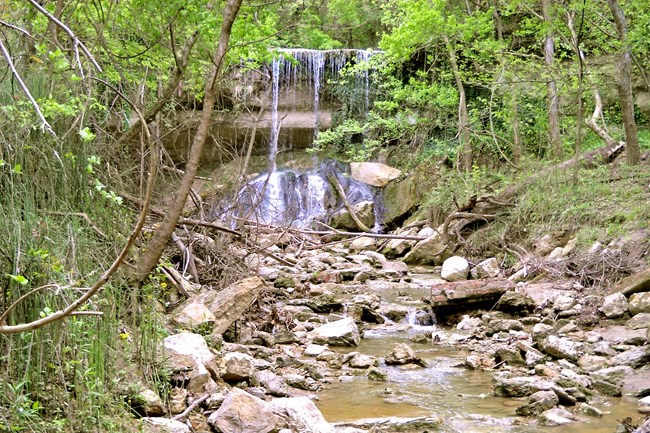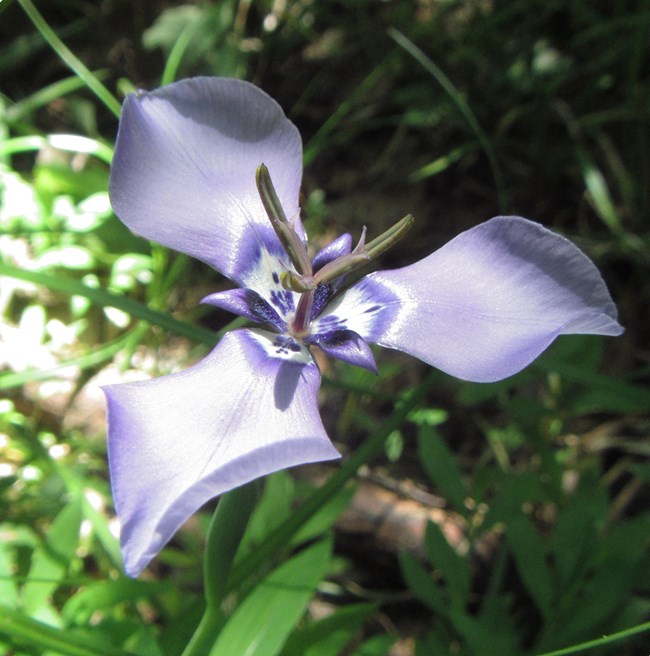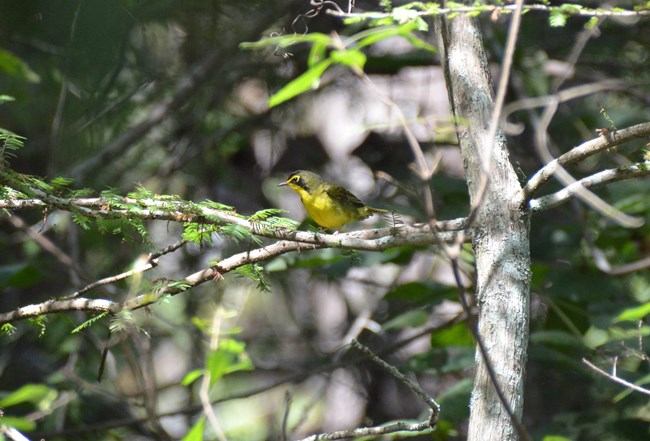
GULN/NPS
Overview
Vicksburg National Military Park is a 735-hectare (1,815-acre) park that commemorates one of the most decisive campaigns of the Civil War, the 1863 Siege of Vicksburg. Today, the park's vegetation differs markedly from the open, relatively treeless landscape of 1863. The park now consists of a mix of forested and open grassy areas, along with stream and river habitats. Even so, the abruptly steep, hilly landscape of the park remains unchanged, due to its unique bluffs and surface soils of Pleistocene-age loess. Loess soils are formed from the fine rock powder, or silt, that was created further north by glacial advancement and recession. The powder was then carried down the continent in waterbodies such as the Mississippi River, settled in the floodplains, got swept up by the wind, and was finally deposited on the bluffs of the Mississippi and surrounding areas. Loess soil has the unique characteristic of allowing vertical cuts in the soil without support. However, because the soil was deposited by wind rather than water, it is highly susceptible to erosion when exposed.
Management challenges at the park include erosion, vegetation changes, exotic species and adjacent land-use impacts. Erosion of loess soils on the park has been addressed, in part, by allowing the vegetation to shift away from the open fields described from the Battle of Vicksburg. The park's close proximity to the city of Vicksburg has also contributed to landscape change by introducing exotic-plant and feral-animal species. The nearby city negatively impacts the air and water quality as well. Higher water temperatures have been documented in Glass Bayou and Mint Springs Creek, due in part to increased sedimentation caused by urban development.

GULN/NPS
Ecosystems at Vicksburg National Military Park
There are four main ecosystems in the park:
- Upland forest, covering over 75% of the land area, including some successional forests,
- A few Freshwater wetlands, both forested and unforested,
- Grasslands, covering roughly 20% of the land area and ranging from relatively unmaintained fields to regularly mowed lawns, and
- Freshwater aquatic ecosystems.
The forest has been described as "mixed mesophytic", which means a relatively diverse mix of broadleaf species that recieve a moderate amount of rainfall. The dominant tree species are sweetgum (Liquidambar styraciflua) and water oak (Quercus nigra) with chinkanpin oak (Quercus muehlenbergii) and cherrybark oak (Quercus pagoda) being common as well. Some native plants of the understory include redbud (Cercis canadensis), sassafrass (Sassafras albidum) and intermittent stands of native cane (Arundinaria gigantea).There are also some occasionally-flooded forests of stream bottomlands with sycamore (Platanus occidentalis), sweetgum and boxelder (Acer negundo), as well as a floodplain forest of back willow (Salix nigra) on the Yazoo River Diversion Canal.

Billy Finney/NPS
The successional forest areas have a high abundance of black locust (Robinia pseudoacacia), tulip poplar (Liriodendron tulipifera), sweetgum, boxelder, and/or mixed vine species. These successional areas may also be invaded by non-native paper mulberry (Broussonetia papyrifera) or chinaberry tree (Melia azedarach). Other problematic invasive plants in the park are Chinese privet (Ligustrum sinense), Japanese honeysuckle (Lonicera japonica) and trifoliate orange (Poncirus trifoliata). Kudzu vine (Pueraria montana var. lobata) has at times been heavily invasive in the park, but removal efforts have also been effective.
The grasslands and mowed lawns are primarily non-native grasses such as bahiagrass (Paspalum notatum) Johnsongrass (Sorhum halepense), Bermuda grass (Cynodon dactylon) and tall fescue (Schedenorus phoenix). Some of these grassy areas offer striking spring-time displays of a native wildflower: the prairie nymph Herbertia lahue. There is also a small section of marsh within the park, dominated by sand spikerush (Eleocharis montevidensis), as well as aquatic ecosystems associated with Glass Bayou and Mint Springs Creek.
With its mix of forests, fields and streams, Vicksburg National Military Park offers excellent birdwatching, with nearly 100 species that can potentially be seen. The wetter places on the park also provide habitat for many amphibian species, including three-lined salamanders (Eurycea guttolineata), dusky salamanders (Desmognathus conanti), spotted salamanders (Ambystoma maculata), American toads (Anaxyrus americanus), and eastern spadefoot toads (Scaphiopus holbrookii), to name a few.

Billy Finney/NPS

Jane Carlson/NPS
Vital Signs Monitored at Vicksburg NMP
The Gulf Coast Network monitors three indicators of ecological health—called vital signs — at this park. They are:
Source: NPS DataStore Saved Search 3713. To search for additional information, visit the NPS DataStore.

Jane Carlson/NPS
Last updated: August 21, 2024
